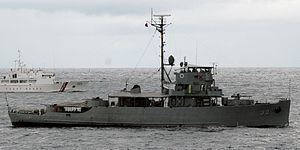Name PCE-897 Commissioned 6 January 1945 Construction started 16 December 1942 | Laid down 16 December 1942 Name Iloilo Launched 3 August 1943 | |
 | ||
Builder Willamette Iron and Steel Works, Portland, Oregon Fate transferred to the Philippine Navy, July 1948 | ||
BRP Iloilo (PS-32) is a Miguel Malvar-class corvette of the Philippine Navy. She was originally built as USS PCE-897, a PCE-842-class patrol craft for the United States Navy during World War II. She was decommissioned from the U.S. Navy and transferred to the Philippine Navy in July 1948 and renamed RPS Iloilo (E-32) after the Philippine province of the same name. The ship is in active service. Along with other World War II-era ships of the Philippine Navy, Iloilo is considered as one of the oldest active fighting ships in the world today.
Contents
History
Commissioned in the US Navy as USS PCE-897 in 1945, and was decommissioned after World War II.
She was then transferred and commissioned into the Philippine Naval Patrol and was renamed RPS Iloilo (E-32) in July 1948. She was carried on to the Philippine Navy in 1950, and between 1965-1966 she was renamed as RPS Iloilo (PS-32) using a new classification system. Again in June 1980 she was renamed BRP Iloilo (PS-32) using a new localized prefix.
Between 1990 and 1991 the Iloilo underwent major overhaul, weapons and radar systems refit, and upgrade of communications gear.
She is currently assigned with the Patrol Force of the Philippine Fleet.
On December 2009, Iloilo and BRP Alberto Navarette (PG-394) conducted sea surface search and rescue operations for any survivors on the sinking of MB Baleno 9.
From 2 April to 17 April 2011, the Iloilo, acting as an escort vessel for BRP Dagupan City (LC-551) conducted a joint logistics run (LOG Run) and Southern Cruise for PMA Batch 2014.
Technical details
There are slight difference between the BRP Pangasinan as compared to some of her sister ships in the Philippine Navy, since her previous configuration was as a patrol craft escort (PCE), while the others are configured as rescue patrol craft escort (PCER) and minesweepers (Admirable-class) ships.
Armaments
Originally the ship was armed with one forward Mk.26 3"/50 caliber dual purpose gun, three aft twin Mk.1 Bofors 40 mm guns, four Mk.10 20 mm Oerlikon guns, 1 Hedgehog depth charge projector, four depth charge projectiles (K-guns) and two depth charge tracks. This configuration applies before its overhaul in the early 1990s.
During its overhaul and refit between 1990 and 1991, the Philippine Navy removed her old anti-submarine weapons and systems, and made some changes in the armament set-up. Some sources claim the loss of its three Bofors 40mm cannons during the 1990-1991 overhaul and refit period, but photos [1] at of 2011 show the Bofors guns still present, although in singles instead of twins. Final armaments fitted to the ship are one Mk.26 3"/50-caliber gun (fore), three single Bofors 40 mm cannons (aft), four Mk.10 Oerlikon 20 mm cannons (2 each on bridge wings), and four M2 Browning 12.7 mm/50 caliber machine guns (2 besides main bridge, 2 aft near the lower Bofors gun tub). This made the ship lighter and ideal for surface patrols, but losing her limited anti-submarine warfare capability.
Electronics
Also during the refit the ship's RCA CRM-NIA-75 surface search radar and RCA SPN-18 navigation radar was replaced by a Raytheon AN/SPS-64(V)11 surface search and navigation radar system. Later modifications included the installation of long range and satellite communications systems, and GPS system standard to all Philippine Navy ships.
Machinery
The ship is powered by two GM 12-278A diesel engines, with a combined rating of around 2,200 bhp (1,600 kW) driving two propellers. The main engines can propel the 914 tons (full load) ship to a maximum speed of around 16 knots (30 km/h).
